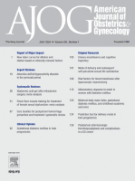First-trimester maternal serum PAPP-A and free-beta subunit human chorionic gonadotropin concentrations and nuchal translucency are associated with obstetric complications: A population-based screening study (The FASTER Trial) - 25/08/11
for the FASTER Trial Research Consortium
Abstract |
Objective |
The purpose of this study was to determine whether maternal serum levels of pregnancy-associated plasma protein A, free-beta subunit human chorionic gonadotropin, or nuchal translucency size are associated with obstetric complications.
Study design |
Data were obtained from the First and Second Trimester Evaluation of Risk trial. Pregnancy-associated plasma protein A and free-beta subunit human chorionic gonadotropin levels were analyzed, and nuchal translucency was measured between 10 weeks 3 days and 13 weeks 6 days of gestation in 34,271 pregnancies.
Results |
Women with pregnancy-associated plasma protein A of ≤5th percentile were significantly more likely to experience spontaneous fetal loss at ≤24 weeks of gestation, low birth weight, preeclampsia, gestational hypertension, preterm birth (P < .001) and stillbirth, preterm premature rupture of membranes, and placental abruption (P < .02). Nuchal translucency at ≥99th percentile and free-beta subunit human chorionic gonadotropin at ≤1st percentile were associated with an increased risk of spontaneous loss at ≤24 weeks of gestation (adjusted odds ratios, 3.90, 3.62, respectively; P < .001).
Conclusion |
Low pregnancy-associated plasma protein A levels in the first trimester were associated strongly with a number of adverse pregnancy outcomes. Low free-beta subunit human chorionic gonadotropin levels and large nuchal translucency were both associated with early fetal loss.
Le texte complet de cet article est disponible en PDF.Key words : Pregnancy-associated plasma protein A, Free-beta human chorionic gonadotropin, Nuchal translucency
Plan
| Supported by National Institute of Child Health and Human Development grant no. RO1-HD 38652. Presented at the Twenty-Fourth Annual Meeting of the Society for Maternal-Fetal Medicine, February 2-7, 2004, New Orleans, La. Reprints not available from the authors. |
Vol 191 - N° 4
P. 1446-1451 - octobre 2004 Retour au numéroBienvenue sur EM-consulte, la référence des professionnels de santé.
L’accès au texte intégral de cet article nécessite un abonnement.
Déjà abonné à cette revue ?

